GO TO: About HAPI | Project Collaborators | Study Status and Metrics
The HAPI project

Project goals
The primary goal of the HAPI project was to reduce exposure to inflammatory agents and allergens in the homes of Latino immigrant children residing in an area of dairy- and crop-based agricultural production in Washington state.
El Proyecto Bienestar, a longstanding community-academic partnership guided by a Yakima Valley community advisory board, has identified pediatric asthma as a priority health concern. This study addressed three components of asthma and environment research: the health of children with asthma living in communities with industrial-scale agricultural operations, asthma in farmworker children and evidence-based intervention strategies in these populations.
About HAPI
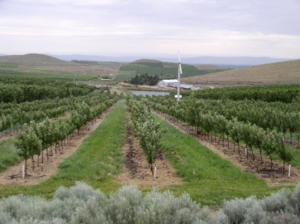
Study overview
Children with poorly controlled asthma aged 6 through 12 years were recruited through the Yakima Valley Farmworker Clinic. They were randomized to the clinic's usual asthma educational program or an enhanced version that included portable high efficiency particulate (HEPA/NH3) air cleaners designed to reduce particles and ammonia. The children were followed for one year with four assessments of asthma health. The cleaners were placed in the child's sleeping area and living room. Children in the usual program group received HEPA/NH3 units after their study year.
Children with asthma in this community experience high morbidity, and our previous research found associations between ambient concentrations of fine particulate matter and ammonia and asthma health outcomes. Since children spend the majority of their time indoors, this study focused on the home indoor environment. Studies conducted in urban settings demonstrate that indoor particulate matter (PM) influences asthma outcomes, and HEPA cleaners can reduce indoor and ambient generated PM. Trials incorporating HEPA portable air cleaners are lacking for rural children. This study sought to characterize key indoor pollutant exposures for approximately 80 children with asthma who reside within 400 meters of crop production or dairy operations. The impact of HEPA cleaners on these exposures and asthma health were examined as well as the modifying influence of caregiver stress.
Project collaborators
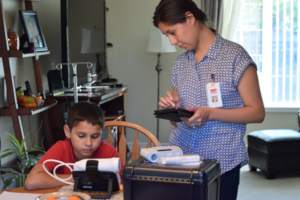
The HAPI project was a collaboration between researchers at the University of Washington Department of Environmental and Occupational Health Sciences and its Pacific Northwest Center for Agricultural Safety and Health (PNASH), and Yakima Valley Community Organizations. Those include the Yakima Valley Farmworkers Clinic (YVFWC) and the Northwest Communities Education Center, which houses Radio KDNA (NCEC/KDNA). These groups, along with Heritage University, comprise El Proyecto Bienestar (EPB), a longstanding research partnership. EPB has conducted research on several community-identified environmental and occupational health priorities, with childhood asthma as the most recent focus. The HAPI study represented a progression from novel characterization of the public health impact of PM2.5 and NH3 in this setting (AFARE Study) to an intervention trial to reduce these exposures and reduce asthma morbidity among children with asthma (HAPI Study). EPB community partners in the Yakima Valley played an essential role in all aspects of the study, including participant recruitment and retention, outreach, health and exposure assessment, results dissemination and formation of future efforts to mitigate air pollution impacts on asthma health.
Study status and metrics

The six-year project concluded in 2020. Three to six new families were enrolled in the project every month through a rolling admission process, and families were followed for one year. Environmental contaminant measures were conducted during two-week sampling periods, performed both pre- and post-randomization, approximately one year apart.
Key data collected during the study included:
Environmental measurements in or around the child's home:
- Child sleeping area:
- PM2.5 (RTI Micropem include hyperlink to https://www.rti.org/impact/micropem-sensor-measuring-exposure-air-pollu…)
- PM10(RTI Micropem include hyperlink to https://www.rti.org/impact/micropem-sensor-measuring-exposure-air-pollu…)
- NO2 (Ogawa badge include hyper link to http://ogawausa.com/passive-sampler/)
- NH3 (Ogawa badge badge include hyper link to http://ogawausa.com/passive-sampler/)
- Antigens in settled dust: cockroach, mouse, dust mite, cat, dog, endotoxin (electrostatic dust cloth- EDC)
- HEPA air cleaner use (Hobo device)
- Living room area:
- PM2.5 (RTI Micropem -- include hyperlink to https://www.rti.org/impact/micropem-sensor-measuring-exposure-air-pollu…)
- HEPA air cleaner use (Hobo device)
- Outdoors:
- NH3 (Ogawa badge badge include hyper link to http://ogawausa.com/passive-sampler/)
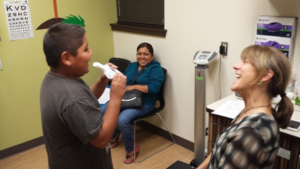
Health measurements and questionnaires:
- Spirometry (measure of lung function)
- Exhaled nitric oxide (measure of airway inflammation)
- Atopy (skin prick testing)
- Asthma Control Test
- Home Environmental Observation Checklist
- Time Activity Questionnaire
- Caregiver Psychosocial Questionnaire
Stress measures (questionnaires):
- Depression Measure (PHQ9)
- Perceived Stress Scale
- Hispanic Stress Inventory
- Additional questions related to: perception of safety, exposure to violence, and stress related to asthma
Total Exposure Monitoring Unit (TEMU) device
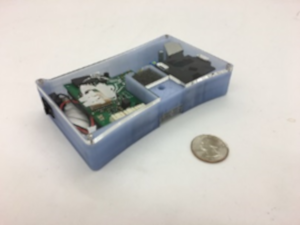
Study primary questions
Upon completion of the data collection, we evaluated the effectiveness of this HEPA air cleaner intervention, addressing the following questions:
- Is the use of portable indoor air cleaners an acceptable approach for families of children with asthma in this community?
- Does use of air cleaners in this setting reduce exposure to particulate matter and ammonia?
- Does using HEPA air cleaners in the home improve asthma health outcomes over and above the "usual" asthma education program?
Findings
In the first 50 participants, we observed:
- General acceptability of HEPA air cleaners in a rural, Latino immigrant farm worker population.
- Indoor PM2.5 concentrations lower than in other inner-city urban asthma studies but at levels associated with asthma health effects in the published literature.
- Indoor NH3 concentrations--higher concentrations than most reports, indoor/outdoor ratio consistent with other reports
- At pre-randomization visit, we found:
- clinically relevant lack of asthma control in 20% of subjects.
- increased pulmonary inflammation in 30% of subjects.
- evidence of airway obstruction in 13% of subjects.
Communication and community engagement
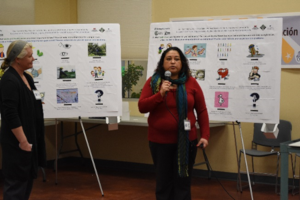
- Ongoing progress discussed at bimonthly EPB Community Advisory Board meetings
- Project results shared with community partners on an ongoing basis through meetings and a dedicated website.
Presentations
DEOHS Seminar, Dec 2015
EPA Child Health Month, 2016
Western Migrant Stream Forum, 2016
ISES 2017 PNASH Showcase, Feb 2017
PRISMS, May 2017
PANWAT, October 2017
WSPHA, Oct 2017
Webinar (December 2016)
PNASH Research Review October 2017
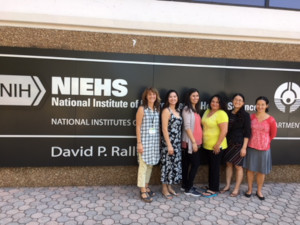
Media coverage
Newspaper, March 2017: Asthma study hopes to improve disease management among Valley children. Yakima Herald (M Rosbach).
Award, January 2017: Dr. Karr Presidential Early Career Award http://www.washington.edu/news/2017/01/10/two-uw-professors-win-preside….
Publications
Riederer AM, Krenz JE, Tchong-French MI, Torres E, Perez A, Younglove LR, Jansen KL, Hardie DC, Farquhar SA, Sampson PD, Karr CJ. Effectiveness of portable HEPA air cleaners on reducing indoor PM2.5 NH3in an agricultural cohort of children with asthma: A randomized intervention trial. Indoor Air. 2021 Mar;31(2):454-466. doi: 10.1111/ina.12753. Epub 2021 Jan 22. PMID: 32996146.
Riederer AM, Krenz JE, Tchong-French MI, Torres E, Perez A, Younglove LR, Jansen KL, Hardie DC, Farquhar SA, Sampson PD, Karr CJ. Effectiveness of portable HEPA air cleaners on reducing indoor endotoxin, PM10,and coarse particulate matter in an agricultural cohort of children with asthma: A randomized intervention trial. Indoor Air. 2021;00:1–14 DOI: 10.1111/ina.12858 PMID: 34288127
Masterson EE, Younglove LB, Perez A, Torres E, Krenz JE, Tchong French MI, Riederer AM, Sampson PD, Metwali N, Min E, Jansen KL, Aisenberg G, Babadi RS, Farquhar SA, Thorne PS, Karr CJ. The home air in agriculture pediatric intervention (HAPI) trial: Rationale and methods. Contemp Clin Trials. 2020 Sep;96: Epub 2020 Jul 25. PMID: 32721578; PMCID: PMC7494646.
Drieling R et al. Randomized trial of a portable HEPA /air cleaner intervention to reduce asthma morbidity among Latino children in an agricultural community. Environmental Health. Major revisions pending, Sept 2021. Preprint available at: https://www.researchsquare.com/article/rs-621994/v1
Research co-investigator team contact information
University of Washington

Catherine Karr, MD, PhD
Principal Investigator
University of Washington
206-851-5577
ckarr@uw.edu
Edmund Seto, PhD
Co-Investigator (TEMU Project lead)
University of Washington
206-543-1475
eseto@uw.edu
Mike Yost, PhD
Co-Investigator (Exposure Science)
University of Washington
206-685-7243
airion@uw.edu
Gino Aisenberg, PhD
Co-Investigator (Psychosocial Stress)
University of Washington
206-616-9365
ginoa@uw.edu
Anne Riederer, PhD
Co-invesigator (Exposure Science)
University of Washington
anneried@uw.edu
Stephanie Farquhar, PhD
Co-Investigator (Evaluation)
University of Washington
206-263-8805
farqs@uw.edu
Research Staff: Lisa Younglove, Maria Tchong-French, Jen Krenz, Karen Jansen, Pablo Palmandez
Graduate Students: Ryan Babadi, Esther Min, Orly Stampfer

El Proyecto Bienestar contact
YVFWC -- Adriana Perez
Radio KDNA/NCEC -- Elizabeth Torres, Carmen Mireles
Funding
Funding and support for this project has been provided by the National Institute for Environmental Health Sciences (NIEHS # 5R01ES023510) and the Interdisciplinary Center for Exposures, Diseases, Genomics, and Environment (EDGE Center, NIEHS grant # 5P30ES007033). Funding and support for the TEMU Pediatric Research Using Integrated Sensor Monitoring Systems (PRISMS) program has been provided by the National Institute of Biomedical Imaging and Bioengineering (NIH NINIB #1U01EB021923).